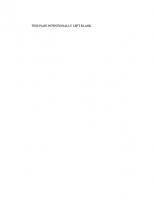Antiquities of Southern Phrygia and the Border Lands 9781607244813, 1607244810
Survey of finds and literary sources documenting the cities of imperial Roman Phrygia's borderlands.
233 43 7MB
English Pages 76 [75] Year 2009
Recommend Papers

- Author / Uploaded
- William M. Ramsay
File loading please wait...
Citation preview
Antiquities of Southern Phrygia and the Border Lands
A n a l e c t a Gorgiana
252 Series Editor George Kiraz
Analecta Gorgiana is a collection of long essays and
short
monographs which are consistently cited by modern scholars but previously difficult to find because of their original appearance in obscure publications. Carefully selected by a team of scholars based on their relevance to modern scholarship, these essays can now be fully utili2ed by scholars and proudly owned by libraries.
Antiquities of Southern Phrygia and the Border Lands
W. M. Ramsay
w
1 gorgia? press 2009
Gorgias Press LLC, 180 Centennial Ave., Piscataway, NJ, 08854, USA www.gorgiaspress.com Copyright © 2009 by Gorgias Press LLC Originally published in All rights reserved under International and Pan-American Copyright Conventions. No part of this publication may be reproduced, stored in a retrieval system or transmitted in any form or by any means, electronic, mechanical, photocopying, recording, scanning or otherwise without the prior written permission of Gorgias Press LLC. 2009
1
ISBN 978-1-60724-481-3
ISSN 1935-6854
Extract from The American Journal of Archaeology, vols. 3 & 4 (1887;1888).
Printed in the LTnited States of America
ANTIQUITIES OF SOUTHERN PHRYGIA AND THE BORDER LANDS. I. It is impossible to discuss the southern cities and frontier of Phrygia without discussing the cities on the other side of the frontier. If the site of each city we?e proved by epigraphic evidence of the name, found on the spot, the case would be different: but a number of names can be placed only by balancing evidence, whose value depends on the ancient condition of a wide extent of country. It happens that the central cities of western Pamphylia (I use the word in the late-Roman and Byzantine sense) are almost all fixed by independent epigraphic evidence, but the Pamphylian cities on the Phrygian frontier can be placed only by an investigation extending over the entire province of Pamphylia Secunda. Hence, the rather complicated plan of the present paper is forced on me. I discuss the border, city by city, and, after fixing the position of each city, mention any facts about its history in ancient time which seem to be as yet unknown. Prof. Hirschfeld's careful Reisebericht (Berlin MonaUber., 1879) has been most useful: I am the more anxious to lay stress on this, as the want of positive identifications in this district would lead those who look merely at definite positive results to undervalue his work. Clear statement of geographical facts and of ancient authorities make his work continually suggestive to the student,—far more so than if he had made a series of guesses, on insufficient evidence, at the ancient names of the sites which he visited.1 Since Leake, guesses are no longer allowable: no other person's guesses can compete with his in authority, and modern travellers must rest on definite balancing of evidence. Each new guess at a name makes a new difficulty in the progress of our knowledge. A.
PHRYGIA.
I. LAODIKE1A.—I may contribute a few* points toward the history of this important city, a detailed study of which is very much required. ' I refer to liis work as Hirschf., p. — : and to Mr. A. H . SMITH'S article in t h e Journal of Hellen. Stud., 1887, as A. H . S., p. —. W h e r e a coin is mentioned without any reference, it is to be found in Mr. HEAD'S Historia Numorum.
344
ANTIQ UITIES
OF SO UTHERN
PHR Y6IA.
345
1. G A R G I L I U S A N T I Q U U S , Proconsul of Asia. In April 1884,1 copied the following inscription on a fragment of the cornice, buried upside down amid the ruins of a large building on the north side of the stadium. KIANGAAPIANGKAISAPIiEBA5TGKAISABEINHSEBP ItTTIANeYTTATOYrAPriAIOYANTEgKOYKAeiEPGSANTC« . . . Tpajiavw ' A S p i a v t p K a i a a p t hefiaaTW Kal ^a/Selvrj 2e/3[a









